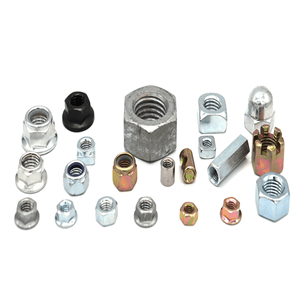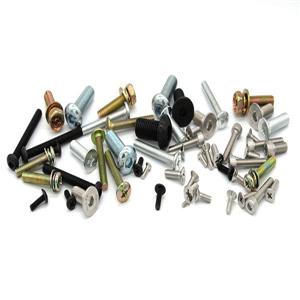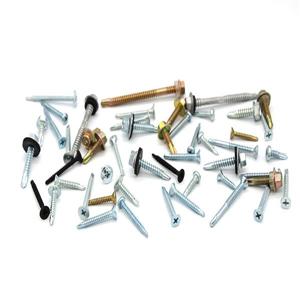Hydrogen embrittlement of alloy steel bolts (4)
5.4.1 Mechanical plating
As early as the 80s of the last century, my country's automobile industry introduced foreign technology to mechanically galvanize to solve the problem of hydrogen embrittlement and cracking of spring washers, and issued the machinery industry standard JB/T 8928-1999 "Mechanical galvanizing of steel and iron parts." The standard stipulates that this kind of coating (Type II) shall not be allowed to appear "white rust" after a 72-hour neutral salt spray test.
On the basis of the research of foreign advanced technology, Hangtian 703 developed the mechanical zinc-tin-aluminum alloy technology. Before coating, sandblasting is used to remove the surface oxide scale. During coating, the coated metal powder is mixed with glass balls, rolled in water, and the metal powder is "cold welded" on the surface of the part through mechanical impact. This process avoids the electrodeposition process, and there is no hydrogen absorption environment. The corrosion resistance of the coating can meet the requirements of the corresponding zinc coating with the same thickness. After 96 hours of neutral salt spray test, there is no "white rust". Therefore, this process can be used to replace the electroplating process, which is currently mainly used for elastic parts. The main problem of mechanical plating is that the bonding force of the coating needs to be further improved and improved.
5.4.2 Powder sherardizing
The mechanism of powder sherardizing is to place zinc powder and steel parts in a closed vacuum container and heat to about 400°C to diffuse the active zinc atoms to the surface of the steel parts, forming a sherardizing layer on the surface of the parts. The thickness of the sherardizing layer can be controlled within 10μm~110μm, generally 25μm~40μm, to replace the zinc coating. The sherardizing layer has good wear resistance, corrosion resistance and high temperature resistance. The maximum working temperature can reach 600 ℃, and the corrosion resistance life can reach 20 years in the atmospheric environment. The biggest feature of sherardizing is that there is no additional coating thickness, which is especially suitable for threaded parts where the coating gap is not expected. It is widely used in fasteners, structural parts, castings, etc. in industries such as transportation, electric power, construction, shipbuilding, and ocean engineering. Some aerospace products also use this coating on bolts for ground equipment systems.
Regarding the powder sherardizing standard, China adopted the British Standard BS 4921-1988 "Powder Sherardizing of Iron and Steel" in 1999, and revised JB/T 5067-1991 to JB/T 5067-1999 "Powdered Sherardizing of Steel and Iron Parts".
The hazardous substance hexavalent chromium (Cr+6) has been banned from entering the market at home and abroad. In this context, the chromium-free Dacromet coating came into being, and my country's machinery industry standard JB/T 10619-2006 "Chromium-free zinc-aluminum coating technical conditions" was issued under this background.
5.4.3 Dacromet coating
Dacromet coating, also known as "non-electrolytic flake zinc powder coating", includes chromium-containing coatings and chromium-free coatings. Because Dacromet coating has excellent corrosion resistance and has no hidden danger of hydrogen embrittlement, it has been widely used worldwide. my country has successively issued GB/T 5267.2-2000 "Non-electrolytic zinc flake coating for fasteners" (equivalent to ISO 10683: 2000), GB/T 18684-2002 "Zinc-Chromium Coating Technical Conditions" and JB/T 10619- 2006 "Technical Conditions of Chromium-Free Zinc-Aluminum Coating".
The coating process of Dacromet coating is to degrease and shot the parts to remove the surface oxide scale, then put the parts into the prepared slurry and soak; after spinning dry with a centrifuge, in an oven at about 300°C The number of drying and bake coatings depends on the thickness of the coating.
The outstanding advantage of Dacromet coating is excellent corrosion resistance, especially in salt spray environment, its corrosion resistance is far better than that of cadmium and zinc coatings (the general electroplating layer can not appear white rust after 96h salt spray test) .
The biggest disadvantage of Dacromet coating is that the bonding force is not as good as that of electroplated layer, but it should be said to be sufficient as a protective layer for fasteners. In order to verify this problem, we use the test method (cross-cut method) of the adhesion of the electroplated layer to evaluate the Dacromet coating. The results showed that the film between the grid lines did not peel off, and the bonding force of the Dacromet coating could meet or approach the requirements of the zinc coating.
However, the acid resistance of Dacromet coating is not very satisfactory. Dacromet coating bolts that work outdoors are difficult to withstand the erosion of acid rain. In addition, some Dacromet coatings contain harmful substances, hexavalent chromium (Cr+6), which is currently prohibited from entering the market at home and abroad. In this context, the chromium-free Dacromet coating came into being, and my country's machinery industry standard JB/T 10619-2006 "Chromium-free zinc-aluminum coating technical conditions" was issued under this background.




